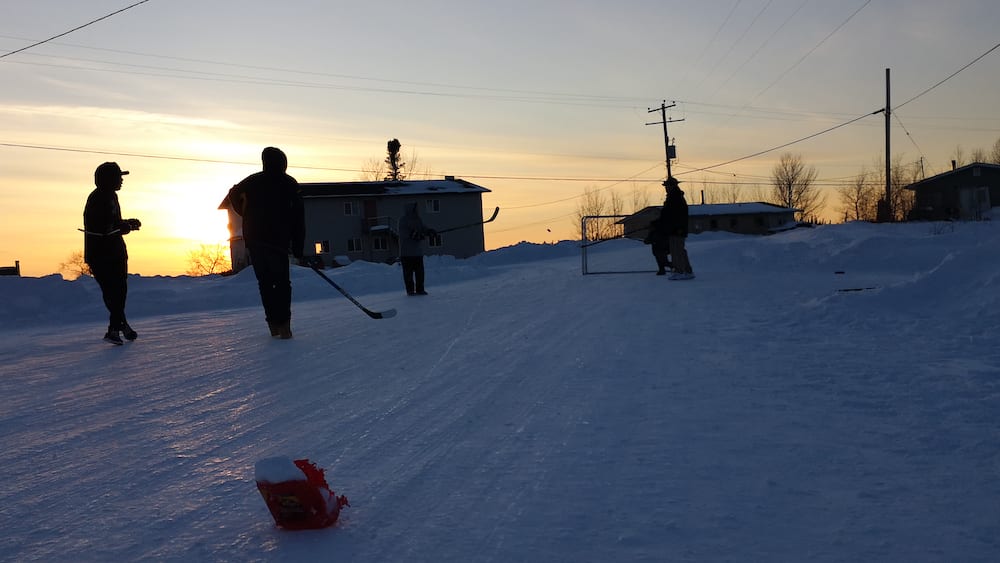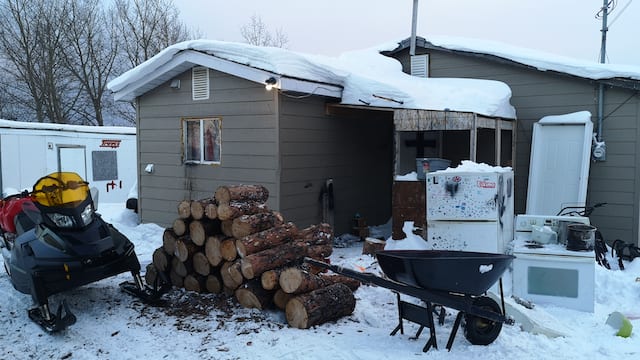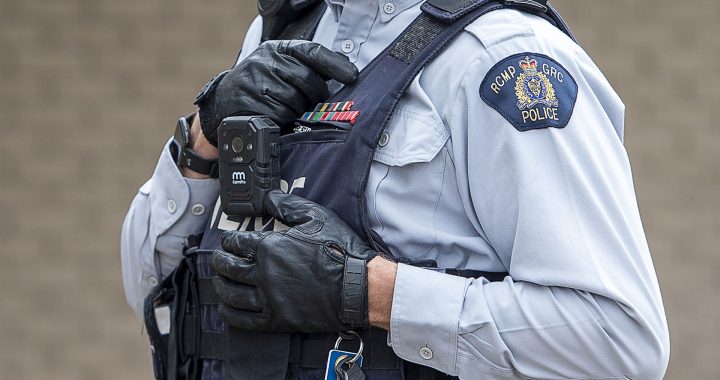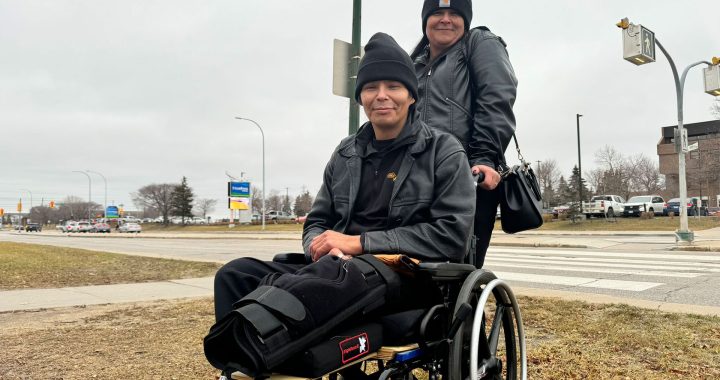Willow Fiddler – APTN News
Lucas Mezzetay chases a puck on the hard-packed snow, just up the road from his family’s home.
A silver net with white mesh sits at one end of the impromptu rink. At the other end, a beat up Folger’s coffee container.
Mezzetay and eight other boys are silhouetted by a majestic northern sunset behind them.
Nearby, three young girls laugh as they run down the road.
They’re playing Knock, Knock, Ginger.
“You knock on random people’s doors and then run away,” one of them explains, chuckling.
For now, the children are free.
But when their games end they will return to homes infested with toxic mould.
Where, instead of a safe place of refuge, each breath risks potential illness.
Recent government and independent inspections confirmed what some in the Ojibway community of more than 500 have known for years.
Mould is everywhere. Sometimes detectable. Often not.
It’s in the walls. Under the floors. Behind appliances. Inside the ceilings.
Little do the children know that in a matter of days a white man will arrive by plane, and with the stroke of a pen ease some of their families’ illnesses and worries.

Lucas Mezzetay and other children play road hockey in Cat Lake. (Justin Brake/APTN)
Indigenous Services Canada Minister (ISC) Seamus O’Regan will sign a final agreement with Cat Lake leaders, which members of the band council tell APTN News could happen as early as Thursday.
In January Cat Lake leaders declared a state of emergency and said they may have to evacuate the community in the absence of immediate relief for their housing and health crisis.
In a Feb. 7 interview with APTN, Chief Matthew Keewaykapo called the situation “critical” and “life-threatening,” adding the community has “lost elders from respiratory problems, we lost children.”
More than a month later a deal between the First Nation and Canada is expected to reflect the terms set out in an interim agreement signed by leaders on Feb. 21 in Thunder Bay, more than 400 kilometres south of Cat Lake.
The community will get 15 new housing units, have 21 others repaired or renovated, and see 10 mobile homes brought into the remote area for short-term relief as families await their homes to be made safe.
Some will get reprieve from the mould. Others will have to wait for help at another time.
States of emergency. Crises.
It wasn’t always this way.
“He thought he was going to die”
Sarah Mezzetay, Lucas’s grandmother, hopes she will be one of the lucky few to get a new home once Keewaykapo signs the agreement.
Weeks ago she was in a London, Ont. hospital with her 8-year-old grandson, who was so sick he couldn’t speak.
Lucas was medevacced out of the community to hospitals in Sioux Lookout and Thunder Bay before being transported to London.
“He never woke up for 10 days — he just sleeps,” Mezzetay recalls, seated in the living room of her small four-bedroom home, where she lives with three of her adult children and four of her grandchildren.
Before he went silent, when he was in Sioux Lookout, Lucas told his grandmother, “‘I think I’m going to die,’” Mezzetay says.
“And I said to him, you’re not going to die.
“I was just scared to lose him,” she says, holding back tears, “because I love my grandkids.”
Doctors told Mezzetay Lucas had a reaction to his medication. But Mezzetay believes it was his exposure to mould in their home.
The same source, she says, of her three-year-old granddaughter’s eczema, and of the asthma that is preventing Mezzetay from working.

Lucas and his grandmother, Sarah Mezzetay, in their Cat Lake home. (Justin Brake/APTN)
Mezzetay is a full-time homemaker who helps elders in the community. Her husband passed away a few years ago, which makes her a single mother and grandmother.
The Feb. 21 interim agreement between Cat Lake and the federal government contains a list of houses to be replaced or repaired based on the results of home inspections.
Mezzetay’s house number isn’t on that list, although a recent inspection found mould in her living room, kitchen, bathroom and basement, while noting “potential” for more mould behind walls and under the subfloors.
Joyce Cook, a Cat Lake councillor who has taken a lead on the housing crisis in her community, says the band has asked Canada to provide the community with four additional mobile homes, on top of the agreement, under Jordan’s Principle.
“We need him out of the house right away,” Cook says, speaking of Lucas’s situation. “And the other kids that were seen by the specialists will need to go into those homes immediately, too. There’s no exception.”
If the government provides the First Nation with new housing under Jordan’s Principle, it would be a first, says Cindy Blackstock of the First Nations Caring Society.
Blackstock says while requests have been made under Jordan’s Principle for home renovations to support First Nations children with disabilities, she’s not aware of previous requests to have safe, new homes provided due to mould infestations.
“In my view, Jordan’s Principle provides services and products to children that are identified as necessary to meet their needs and best interests,” says Blackstock.
“It is not up to Canada to second guess professionals on the ground, so if a mould-free home is identified as necessary, either short- or long-term, it is up to Canada to provide it.”
APTN asked ISC for comment on Cat Lake’s Jordan’s Principle request, but did not receive a response by the time of publication.
Last month, two doctors—a paediatric respirologist and an infectious disease specialist—visited the community to assess sick children.
They produced a report for ISC and the band, but the results haven’t been made public.
David Miller, a toxicologist and chemistry professor at Carleton University, is a leading expert on mould in indoor environments and has worked with northern Ontario communities.
He says those allergic to fungi are most at risk, “because if you are exposed to them you’re going to be sick all the time.”
His second concern is for children, “because they’re our future.”
Miller testified before the federal government’s finance committee last year, when he explained how federally funded houses were largely insufficient for northern climates, and that more housing is needed to remedy overcrowding.
“The houses are not appropriate for the environment, and the way they’re run leads to the conditions that you see,” he says, explaining the government offers little support on how to maintain the houses in the northern climate.
Seated next to his grandmother, Lucas plays on a smartphone. He’s quiet, looks up and smiles every few minutes — but doesn’t say much.
It’s a different upbringing than his grandmother’s.
Mezzetay was born “in the bush,” she says. Like many in the community, she was raised in a log cabin. Her father was a trapper.
Though they lived without amenities like plumbing and electricity, Mezzetay says their homes weren’t mould-ridden.
Most houses in the community were built in the 1970s and ‘80s. They lack adequate insulation and ventilation, which creates conditions for mould.

Most houses in Cat Lake were built, insufficiently, in the 1970s and ’80s. (Justin Brake/APTN)
For at least a couple decades now community leaders say they’ve been trying to get the government’s attention.
Last August, ISC sent Environmental Public Health Officers to the community. They inspected 107 homes.
Fifty-three were found to have no visible mould, ISC spokesperson Rola Tfaili said in an email to APTN.
Forty-eight had “a small amount of visible mould present, four homes had a moderate amount of visible mould present, and two homes had extensive visible mould present.”
Following the inspections, ISC provided the results to community leaders, including “advice on how to control and remediate any mould found in the homes,” said Tfaili.
With dozens of children and youth sick with skin conditions and lung infections, according to Cat Lake leadership, they knew something wasn’t right. So they requested more thorough inspections.
In mid-December the government funded third-party inspectors, who turned up different results.
Keewaykapo said those inspections found 87 homes with “severe mould.” That number later rose to almost 100, after further inspections.
The state of emergency was declared a few weeks later.
On Feb. 18, Nashie Oombash—a 48-year-old mother and grandmother from Cat Lake, and Sarah Mezzetay’s sister—died in a Thunder Bay hospital.
Oombash’s family has said her death was the result of health complications from living in a mould-infested home.
Three days later the federal government promised help.
Confusion, uncertainty over who whose homes will be made safe
On March 7, Cook went on community radio to update the community on the band’s dealings with Canada.
It was the first time many in the community heard details of the interim agreement.
Cook told APTN that day the band was still negotiating for more than the government had committed to.
She said virtually every home in the community required mould remediation.
At the Feb. 21 interim agreement signing, Cook and Keewaykapo thanked O’Regan for his commitment to the community, calling it “a start.”
In a video posted to his Twitter account, O’Regan said the feds were committing to “57 housing units…36 of them are new and new portable units.”
It is critical to work directly with Cat Lake leadership to address the housing and health concerns for residents, and to do so quickly.
That is exactly what we have done in signing an agreement today. Here is what it means for all of us ⬇️ pic.twitter.com/Wxg81tZJuV
— Seamus O’Regan () February 21, 2019
While in Cat Lake last week, APTN learned 11 of the new housing units O’Regan cited in his Feb. 21 tweet are already under construction and incomplete due to funding shortages.
They include a seven-plex building, funded under Canadian Mortgage and Housing Corporation, and two duplexes.
“Indeed the 11 units are part of the total number of new constructions as announced in [O’Regan’s] Statement,” ISC spokesperson William Olscamp confirmed by email.
“However, the funding for them is not included as part of the new funding mentioned in the statement.”
Despite knowing about the housing crisis, the government withheld the second instalment of almost $750,000 to complete the seven-plex, pending receipt of Cat Lake’s financial statements for the fiscal year 2017-18.
The interim agreement promises to release those funds once Canada receives the paperwork.
Olscamp confirmed ISC received the documents on March 7.
The interim agreement promises supplies, including the 10 mobile units, to the community within two weeks.
Yet the materials have not yet arrived — and warm weather threatens to shut down the 150-kilometre winter road to the community.
Cat Lake leaders are also looking to the provincial government for help.
A source with Ontario’s Ministry of Indigenous Affairs told APTN Cat Lake has requested the province’s help building a playground and bike park for youth, and a sawmill.
But the source said Minister Greg Rickford is not entertaining the requests as they don’t help with the community’s immediate needs.
Cook told APTN Wednesday that “everything we ask for has a reason to it.”
She said a playground and bike park would give children and youth a place to go.
“Maybe for [government] it’s a park, but for the kids it’s away from their homes for the time being while houses are being built,” she says.
“You have to have a small mind to think it’s not reasonable to ask for such a thing.”
Cook said a sawmill would give community members a way to build their own cabins.
“There’s a lot of people that would be able to use that if they wanted to build a log cabin, in the community or in the bush,” she explained.

This seven-plex was built with CMHC funding, but has not been completed because the government withheld the funding for its completion despite knowing of the housing crisis. (Justin Brake/APTN)
Last month NDP MP Charlie Angus and NDP MPP Sol Mamakwa, both of whose ridings include Cat Lake, visited the community to see the housing crisis first hand.
They saw the federal government has added another nurse to the community’s nursing station staff.
But Mamakwa is pressing the Doug Ford government to help out, too.
He wants the province to send doctors to the community until the health issues are addressed.
“It’s got to be more than just a one-off visit,” he says. “There needs to be a continuous follow-up with the health of the people.”
He said the community’s request for a playground and bike park “certainly makes sense from a practical point of view,” and that the feds and province need to do a better job co-ordinating a response.
“It’s really critical that the province be involved, and not just on the outside looking in and hoping the feds respond.
“We’re talking about human beings here.”
Cook said details of the final agreement are almost done, and the band is awaiting the government’s decision on the Jordan’s Principle application.
On March 7, the Canadian Paediatric Society (CPS), which represents more than 3,300 paediatricians across Canada, wrote a letter to O’Regan saying the Feb. 21 interim agreement “does not go nearly far enough.”
“Like all children in Canada, the children of Cat Lake have a right to healthy home environments where they can live, play, and grow,” reads the letter signed by CPS President Catherine Farrell and chair of the organization’s First Nations, Inuit and Métis Health Committee, Radha Jetty.
“The consequences of failing to meet this basic need are both acute and chronic, and will affect their current health and future life chances.”
Bobby Oombash wants to raise his children in a safe home on Oombash Point, where his father and grandfather raised their families. (Justin Brake/APTN)
Bobby Oombash’s family is at the top of the list for new homes, according to the interim agreement.
The 30-year-old father of five and his wife are raising their children in the small, two-bedroom home where Bobby grew up.
With both of his brothers deceased, Oombash has taken on the responsibility of hunting and trapping to feed his family, including his parents, who passed on their home to him and now live next door.
But Oombash’s house has poor insulation, and inspectors discovered a leaking pipe in the walls.
“Sometimes I have to keep my fire going all night just to keep the house warm,” he told APTN last week, seated next to the wood stove in his home.
“’Cause once it gets cold the floor gets really cold, and that’s how [the children] get sick.”
Oombash still hasn’t seen the inspection results.
A copy obtained by APTN says inspectors found extensive mould in the home.
“If I had mould in this house I don’t think we would live in here,” Oombash said. “That’s what I was telling my parents — if there was mould in here I probably would’ve burnt it down already, anyway,” he said rhetorically.
Mamakwa, who is the Critic for Indigenous Affairs, said in a March 7 letter to Ford the province “has a moral and legal obligation to act now to address the health crisis in Cat Lake.
“As a signatory to Treaty 9, the province is responsible for health in First Nations communities,” he wrote.
Cat Lake housing crisis. There’s no jurisdictionional ping pong here. Ontario is a signatory to Treaty 9. Cat Lake is part of Treaty 9. No more games #onpoli #cndpoli Housing is a #humanright #indigenous #wearepeopletoo pic.twitter.com/ZK2PDkK6DP
— Sol Mamakwa MPP () February 8, 2019
While there’s a disconnect between past promises and the reality on the ground in Cat Lake, families like Oombash’s are trying hard to avoid further disruption.
If he gets a new house, Oombash wants to pass it on to his children.
“If my house gets demolished, I asked if they could rebuild a house here, because I don’t want to leave this point,” he said, explaining his grandfather lived in the same spot, a desirable location from which you can see both sides of the lake.
Oombash said he plans to teach his kids how to raise their own families. And he wants them to be able to do it in the safety and comfort of their family home.
“What I know is what I want them to do, too,” he said. “I pass my traditional things on to them.”
wfiddler.ca









